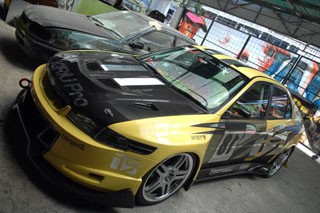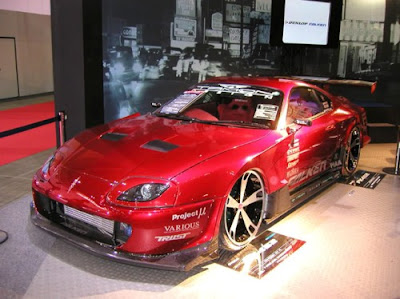 Honda took the wraps off its innovative, yet butt ugly, FCX fuell-cell powered vehicle at the Los Angeles Auto Show. The production version of the FCX prototype, which was introduced two years ago, will be offered for lease to a limited number consumers in Southern California,
Honda took the wraps off its innovative, yet butt ugly, FCX fuell-cell powered vehicle at the Los Angeles Auto Show. The production version of the FCX prototype, which was introduced two years ago, will be offered for lease to a limited number consumers in Southern California, The FCX Clarity utilises Honda’s V Flow stack in combination with a new compact lithium ion battery pack and a single hydrogen storage tank to power the vehicle’s electric drive motor. The fuel cell stack operates as the vehicle’s main power source providing a range of 270 miles (approx 430 km). -Continued after the jump






Press Release - Dynamic styling and performance herald major advances for fuel cell vehicles; limited marketing to begin next summer
Honda today unveiled the FCX Clarity fuel cell vehicle at the Los Angeles International Auto Show, announcing plans to begin limited retail marketing of the vehicle in summer 2008.
The FCX Clarity is a next-generation, zero-emission, hydrogen-powered fuel cell vehicle based on an entirely new Honda V Flow fuel cell platform, and powered by the highly compact, efficient and powerful Honda V Flow fuel cell stack. Featuring tremendous improvements to driving range, power, weight and efficiency – and boasting a low-slung, dynamic and sophisticated appearance, previously unachievable in a fuel cell vehicle – the FCX Clarity marks the significant progress Honda continues to make in advancing the real-world performance and appeal of the hydrogen-powered fuel cell car.
Honda plans to lease the FCX Clarity to a limited number of retail consumers in Southern California,
How the FCX Clarity got its name
Honda chose this name to express the idea that the company is creating a fuel cell vehicle that will offer a clear solution to the challenges of the future, helping society achieve sustainable mobility.
How the FCX Clarity works
The FCX Clarity utilises Honda’s V Flow stack in combination with a new compact and efficient lithium ion battery pack and a single hydrogen storage tank to power the vehicle’s electric drive motor. The fuel cell stack operates as the vehicle’s main power source. Hydrogen combines with atmospheric oxygen in the fuel cell stack, where energy from the reaction is converted into electric power used to propel the vehicle. Additional energy is also generated through the capture of kinetic energy from vehicle braking and deceleration (known as regenerative braking), which is stored along with surplus energy from the fuel cell in the lithium ion battery pack, and is used to supplement power from the fuel cell, when needed. The vehicle’s only emission is water.
Honda V Flow FC Stack
The V Flow FC Stack features an entirely new cell structure that achieves a higher output of 100kW, smaller size and lower weight, with a 50 per cent improvement in output density by volume, and a 67 per cent increase in output density by mass, compared to the previous Honda FC stack.
V Flow FC Stack (Vertical Gas Flow Cell Structure)
The new V Flow FC Stack introduces a cell structure in which hydrogen and air flow vertically, and gravity is used to facilitate more efficient drainage of the water by-product from the electrical generation layer. The result is greater stability in power generation. The new structure also allows flow channel depth to be reduced by 17 per cent – a major contributing factor in creating thinner cells and a more compact stack.
Wave Flow-channel Separators
The V Flow FC Stack incorporates wave flow-channels for the hydrogen and air, with horizontal coolant flow channels weaving between them. The wave flow channels provide greater flow length per channel than straight channels, while the resulting turbulent flow within the channel promotes improved hydrogen and air distribution. As a result, the hydrogen and air are spread over the entire electrode layer, making more efficient use of the compact electrical generation layer and achieving approximately 10 per cent higher generating performance than with straight flow channels. The horizontal coolant flow also ensures more even cooling over the entire electrical generation layer, allowing for a reduction in the number of cooling layers to half that of previous stacks. While the previous stack had one cooling layer for each cell, the new stack needs only one cooling layer per two cells. This results in a 20 per cent reduction in stack length and a 30 per cent weight reduction, which is a major breakthrough in compact, lightweight stack design.
Improved startup capability at low temperatures
Improved water drainage due to the V Flow cell structure facilitates better output immediately after startup. The reduced coolant volume and single-box design made possible by the wave flow-channel separators result in heat mass 40 per cent lower than previous stacks. As a result, startup is now possible at temperatures as low as -30° C.
Honda V Flow fuel cell platform
The FCX Clarity’s revolutionary new V Flow platform packages the ultra-compact, lightweight and powerful Honda V Flow fuel cell stack – 65 per cent smaller than the previous Honda fuel cell stack unit – in the vehicle’s centre tunnel, between the two front seats. The compact size of the new V Flow FC Stack allows for a more spacious interior and more efficient packaging of other powertrain components, which would otherwise be unattainable in a sleek, low-slung sedan.
The FCX Clarity boasts numerous other significant advances in the performance and packaging of Honda fuel cell technology, compared to the current-generation FCX. These include:
- a 20 per cent increase in fuel economy (about 2-3 times the fuel economy of a petrol-powered car, and 1.5 times that of a petrol-electric hybrid vehicle, of comparable size and performance);
- a 30 per cent increase in vehicle range – to 270 miles (approximately 430 km);
- a 120 per cent improvement in power-to-weight ratio, in part due to around a 400-pound (approximately 180kg) reduction in the fuel cell powertrain weight, despite a substantial increase in overall vehicle size;
- a 45 per cent reduction in the size of the fuel cell powertrain – nearly equivalent, in terms of volume, to a modern petrol-electric hybrid powertrain;
- an advanced new lithium-ion battery pack that is 40 per cent lighter and 50 per cent smaller than the current-generation FCX’s ultracapacitor;
- a single 5,000-psi hydrogen storage tank with 10 per cent additional hydrogen capacity than the previous model.
FCX Clarity design
More than just a fuel cell vehicle – the FCX Clarity portrays Honda’s vision of the future of car design and performance, freed from the constraints of conventional powertrain technologies. The FCX Clarity’s four-door sedan platform features a short-nose body and spacious cabin with comfortable accommodation for four people and their luggage. Major powertrain components – including the electric motor, fuel cell stack, battery pack and hydrogen tank – have been made more compact and are distributed throughout the vehicle to further optimise space, comfort and total vehicle performance.
Advanced materials and components
In keeping with its theme as an environmentally-advanced automobile, the FCX Clarity features seat upholstery and door linings made from Honda Bio-Fabric – a newly-developed, plant-based material that offers CO2 reductions as an alternative to traditional interior materials, along with outstanding durability and resistance to wear, stretching, and damage from sunlight.
Designed to appeal to forward-thinking customers seeking the ultimate in zero-emissions, alternative-fuel vehicle performance, the FCX Clarity is also equipped with a full complement of advanced safety, comfort and convenience features. These features consist of a state-of-the-art navigation system with hydrogen station locations, a rear view camera, Adaptive Cruise Control (ACC), Collision Mitigation Brake System (CMBS), a premium sound system, climate controlled seats and Bluetooth™ connectivity.
Other improvements, such as shift-by-wire, electric power steering (EPS), and a newly designed instrument panel with easy-to-read display of hydrogen fuel consumption, further improve its customer appeal and ease of operation.
CO2 emissions
The FCX Clarity’s only emission is water. CO2 emissions related to the production of hydrogen vary by source; however, well-to-wheel CO2 emissions using hydrogen reformed from natural gas – the most widely used method of production today – are less than half that of a conventional petrol vehicle. With the production of hydrogen from water by electrolysis, CO2 emissions can be further reduced and ultimately approach zero if the electricity is generated from sustainable sources, such as solar, wind, hydro and wave power.
In the area of solar technology, Honda has developed its own solar cells, with half the CO2 emissions in the production stage compared to conventional crystalline silicon cells; and has begun mass-production and retail sales of this technology in
For 40 years, Honda has worked hard to reduce the environmental impact of the car, including efforts to reduce emissions, boost fuel efficiency and, now, many industry-leading efforts to advance the hydrogen fuel cell vehicle – a technology and fuel that Honda believes may hold the ultimate promise for a clean and sustainable transportation future. Honda’s pioneering achievements in this area include the first U.S. Environmental Protection Agency (EPA) and California Air Resources Board (CARB) certification of a fuel cell vehicle (2002); the first lease of a fuel cell vehicle (2002); the first fuel cell vehicle to receive an EPA fuel economy rating (2002); the first cold-weather customer (2004); the first and still only individual retail customers (2005, 2007); and the first and still only fuel cell vehicle to be eligible for a U.S. federal tax credit.

























